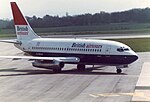Oversleyford
There are places called Oversley elsewhere in England.Oversley and Oversleyford (sometimes Oversley Ford) is a name used for some places in an area near Manchester Airport. Oversleyford Bridge, where the A538 road from Altrincham to Wilmslow crosses the River Bollin Oversley Lodge Farm (as at August 2011 occupied by an asbestos cleanup firm for training) Oversley Farm, and Oversleyford Brickworks, now obliterated by Runway 2 of Manchester AirportThe name is first recorded in the 13th century as Vulverichelei and seems to come from Anglo-Saxon Wulfrīces lēah (Wulfrīc's clearing or meadow). The ford was probably a few yards north of the modern main road Oversleyford Bridge, where a minor road bridges the Bollin; that minor road is now a back entry to a hotel's front yard but was part of the A538 road before it was diverted for a runway extension. The name Oversleyford is at the middle of the south edge of this old Ordnance Survey map.
Excerpt from the Wikipedia article Oversleyford (License: CC BY-SA 3.0, Authors).Oversleyford
Wilmslow Old Road,
Geographical coordinates (GPS) Address Nearby Places Show on map
Geographical coordinates (GPS)
| Latitude | Longitude |
|---|---|
| N 53.3431 ° | E -2.2774 ° |
Address
Wilmslow Old Road
Wilmslow Old Road
SK9 4LR , Styal
England, United Kingdom
Open on Google Maps





